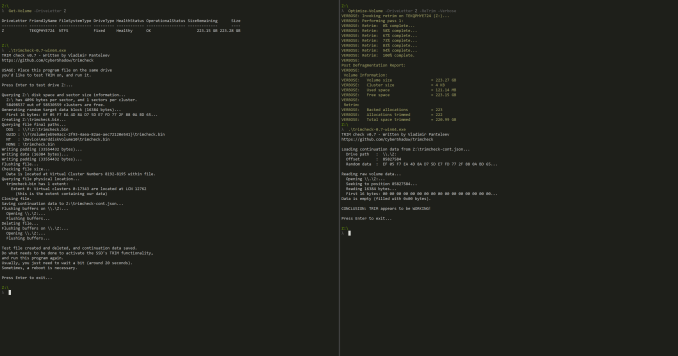TEKQ Rapide Thunderbolt 3 External SSD Review
by Ganesh T S on February 20, 2018 8:00 AM EST- Posted in
- Storage
- SSDs
- DAS
- Thunderbolt 3
Miscellaneous Aspects and Concluding Remarks
The Thunderbolt 3 specifications indicate that the host port must be able to supply up to 15W for bus-powered devices connected to it. Since the TEKQ Rapide is a bus-powered device, it is given that its power consumption can't exceed 15W in order to be a certified Thunderbolt 3 device. It is still relevant to take a fine-grained look at the power consumption profile. Using the Plugable USBC-TKEY, the bus power consumption for the external SSD was tracked while the CrystalDiskMark workloads were processed. The workloads were set up with an interval time of 30s. The power consumption was tracked only for the exFAT version of the CrystalDiskMark workloads.
We find that the peak power consumption is slightly south of 7W. The SSD idles at around 2.5 W.
Support for TRIM is an important aspect - it ensures that performance consistency is maintained even after the SSD has been subject to long-term use. Since the Thunderbolt interface is transparent for all practical purposes, and the host OS sees a PCIe NVMe SSD, it comes down to the Phison E7 reference design supporting TRIM. We were able to successfully activate TRIM on the TEKQ Rapide.
The final aspect that we deal with in the review is the pricing. TEKQ sent over the following pricing table for the three variants.
| TEKQ Rapide Thunderbolt 3 External SSDs - Pricing | |||
| Capacity | Retail | Indiegogo | Amazon |
| 240 GB | $319 | $255 | $300 |
| 480 GB | $479 | $383 | $450 |
| 960 GB | $899 | $719 | $900 |
There are very few bus-powered Thunderbolt 3 external SSDs currently in the market, though a number of them have been announced recently. The only current alternative to the TEKQ Rapide in its price range is the OWC Envoy Pro EX / EX(VE). The 250GB variant of the OWC unit comes in at $280, which is much cheaper than the TEKQ Rapide. That said, the Envoy Pro EX tops out at 1800 MBps. The EX(VE) goes up to 2600 MBps, but carries a hefty price premium. The TEKQ does guarantee a M.2 SSD with MLC NAND flash. While OWC doesn't clarify that aspect for either of their Envoy Pro offerings, it appears likely that the EX uses TLC, while the EX(VE) uses MLC flash. Most of the upcoming Thunderbolt 3 external SSDs are going to be based on the Phison E8 reference design with 3D TLC. In this context, a MLC external SSD such as the TEKQ Rapide is bound to appeal better to a section of the market.
While taking up the review unit, I was expecting to wade through the usual beta-testing bugs (particularly given that TEKQ had not released any high-performance external storage devices before). I was pleasantly surprised that all our tests were processed without a hitch. The performance of the TEKQ Rapide is top-notch and meets the claimed numbers. Adding a user-friendly way to activate the hardware encryption capabilities of the internal SSD would be a nice feature to have, but, it is a minor nit-pick. Our main concern is the pricing (compared to the TLC-using competition in the market) and the availability of flash for TEKQ to ramp up volume and make the device more economical to address the mainstream market.












33 Comments
View All Comments
GoodyMartin - Monday, March 5, 2018 - link
Why the hell you didnt plug a samsung m.2 960 probto maje tests ? You need to plug a higher soeed ssd m.2 and test to see ir resch 2.5gbps of write and if drops soeed or not after filling and wrutw mant times the drivesGoodyMartin - Monday, March 5, 2018 - link
So gt a 960 pro or 960 and plug into this rapide box and giveus test numbers, thats the real important thing for all guys, not the stupid default crappy phison slow m.2 unitSailor23M - Wednesday, April 18, 2018 - link
I would also love to buy just the box without the drive, heck pay a good premium for it too.